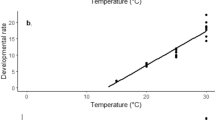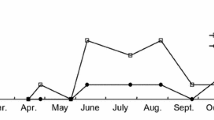Abstract
The development time and survival of the castor whitefly, Trialeurodes ricini Misra were measured at four constant temperatures. The duration of the egg stage varied from 15 days at 20°C to 4.6 days at 35°C. No eggs hatched at a constant 40°C. The minimum temperature threshold for egg development was calculated to be 17°C. The total development time from egg to adult ranged from 54.4 days at 20°C to 16.8 days at 30°C. Development of the egg and the first-to fifth-instar larva required 63 and 180 degree-days respectively above the threshold value. Immature survival increased from 64.5% at 20°C to 92.8% at 30°C. Trialeurodes ricini is well adapted to high temperatures and may extend its distribution if mean world temperatures increase as a result of global warming.
Résumé
Le développement et la survie des Trialeurodes ricini Misra ont été étudiés sous quatres températures constantes de 20 à 35°C. La durée du développement de l’oeuf a varié de 15 jours (20°C) à 4,6 Jours (35°C). Une température constante de 40°C s’est montrée fatale pour les oeufs de T. ricini. Les seuils théoriques de températures pour le développement des oeufs ont été établis à 17°C. La durée du développement de l’oeuf adulte a varié de 54,4 jours (20°C) à 16,8 jours (30°C). Les besoins thermiques pour le développement des oeufs et des nymphes étaient de 63 et 180 degrés-jours au dessus la temperature du seuil. La survie augmente de 64,5% à 20°C, à 92,8% à 30°C. Trialeurodes ricini est bien adapté à des températures, ce qui pourrait résulter en une expansion des zones de prolifération de T. ricini si la température mondiale moyenne augmente, à cause de l’effet de serre.
Similar content being viewed by others
References
Andrewartha H. G. and Birch L. C. (1954) The Distribution and Abundance of Animals. The University of Chicago Press, Chicago, Illinois.
Arnold C. Y. (1959) The determination and significance of the base temperature in a linear heat unit system. Proc. Am. Soc. Hort. Sci. 74, 430–445.
Bink-Moenen R. M. (1983) Revision of the African whiteflies (Aleyrodidae), mainly based on a collection from Tchad. Monografieen van de Nederlandse Entomologische Verenging 10, 1–211.
Butler G. D., Jr., Hennerberry T. J. and Clayton T. E. (1983) Bemisia tabaci (Homoptera: Aleyrodidae): Development, oviposition and longevity in relation to temperature. Ann. Entomol. Soc. Am. 76, 310–313.
Byrne D. N. T., Bellow T. S., Jr. and Parrella M. P. (1990) Whiteflies in agricultural systems, pp. 227–261. In Whiteflies: Their Bionomics, Pest Status and Management (Edited by D. Gerling). Intercept, Andover.
Davidson J. (1944) On the relationship between temperature and rate of development of insects at constant temperatures. J. Anim. Ecol. 13, 26–38.
El-Khadir E. and Khalifa A. (1962) A new Aleyrodid from the Sudan. Proc. R. Entomol. Soc. Lond. B (31), PTS. 3–4, 47–51.
Gerling D., Horowitz A. R. and Baumgaertner J. (1986) Autoecology of Bemisia tabaci. Agric. Ecosyst. Environ. 17, 5–19.
Havron A., Rosen D., Rossler Y. and Hillel J. (1987) Selection on the male hemizygous genotype in arrhenotokous insects and mites. Entomophaga 32, 261–268.
Horowitz A. R. and Gerling D. (1992) Seasonal variation of sex ratio in Bemisia tabaci on cotton in Israel. Environ. Entomol. 21, 556–559.
Howe R. W. (1967) Temperature effects on embryonic development of insects. Annu. Rev. Entomol. 12, 15–42.
Hulspas-Jordan P. M. and van Lenteren J. C. (1989) The parasite-host relationship between Encarcia formosa (Hymenoptera: Aphelinidae) and Trialeurodes vaporariorum (Homoptera: Aleyrodidae). XXX. Modelling population growth of greenhouse whitefly on tomato. Wag. Agric. Univ. Papers 89-2, 1–54.
Lauge G. (1985) Sex determination: Genetic and epigenetic factors, pp. 295–318. In Comprehensive Insect Physiology, Biochemistry and Pharmacology. Vol. I. Embriogenesis and Reproduction (Edited by G. A. Kerkut and L. I. Gilbert). Pergamon Press, Oxford.
Leddy P. M., Paine T. D. and Bellow T. S., Jr (1995) Biology of Siphoninus phyllyreae (Haliday) (Homoptera: Aleyrodidae) and its relationship to temperature. Environ. Entomol. 24, 380–386.
Messenger P. S. (1964) The influence of the rythmically fluctuating temperatures on the development and reproduction of the spotted alfalfa aphid Theiroaphis maculata. J. Econ. Entomol. 57, 71–76.
Mound L. A. and Halsey S. H. (1978) Whitefly of the World. New York, Wiley. 340 pp.
Osborne L. S. (1982) Temperature-dependent development of greenhouse whitefly and its parasite Encarsia formosa. Environ. Entomol. 11, 483–485.
Patel M. M., Naik M. M., Vyas H. N. and Patel A. T. (1986) Evaluation of certain insecticides against whitefly (Trialeurodes ricini Misra) and the jassid (Empoasca keri Pruthi) infesting castor. Indian J. Plant Prot. 14, 81–82.
Powell D. A. and Bellow T. S., Jr. (1992) Preimaginal development and survival of Bemisia tabaci on cotton and cucumber. Environ. Entomol 21, 359–363.
Price P. W. (1984) Insect Ecology. 2nd ed. Wiley, New York. 607 pp.
Roermund H. J. W. and van Lenteren J. C. (1992) The parasite-host relationship between Encarcia formosa (Hymenoptera: Aphelinidae) and Trialeurodes vaporariorum (Homoptera: Aleyrodidae) XXXIV. Life history of the greenhouse whitefly, Trialeurodes vaporariorum as a function of host plant and temperature. Wageningen Agric. Univ. Papers 92, 1–102.
Solomon M. E. (1951) Control of humidity with potassium hydroxide, sulphuric acid, or other solutions. Bull. Entomol. Res. 42, 543–554.
Srivastava A. S., Srivastava J. L. and Tripathi R.A. (1972) Incidence of pests on castor. Labdev J. Sci. Tech. vol. 10-B. No 1.
Yano E. (1981) Effect of temperature on reproduction of greenhouse whitefly, Trialeurodes vaporariorum (Westwood). Bull. Weg. Ornam. Crops Res. Stn. Japan A. 8, 143–152.
Author information
Authors and Affiliations
Additional information
See Editor’s Note at the end of this issue.
Rights and permissions
About this article
Cite this article
Shishehbor, P., Brennan, P.A. Environmental Effects on Pre-Imaginal Development and Survival of the Castor Whitefly, Trialeurodes ricini Misra. Int J Trop Insect Sci 16, 325–331 (1995). https://doi.org/10.1017/S1742758400017355
Accepted:
Published:
Issue Date:
DOI: https://doi.org/10.1017/S1742758400017355




